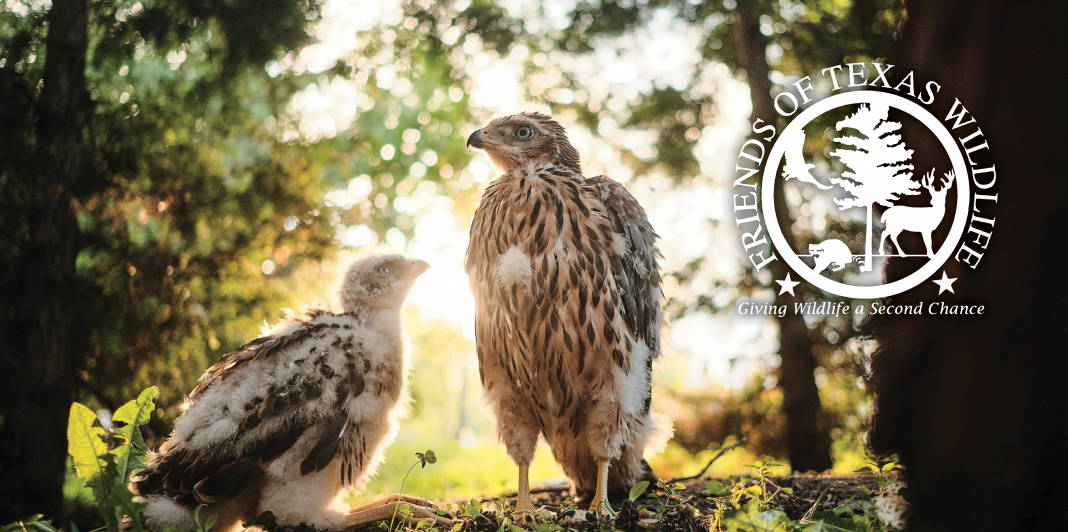We are fortunate in our part of Texas to have four different types of owls that can be found. Quite often at our intake center, we get calls about “baby great horned owls”. In our area, great horned owls are generally hatched early in the year, as early as January. While there are times we do get in baby great horned owls, many times what people actually find are the smallest owl in our area, the Eastern Screech Owl (which in everyone’s defense, do look a lot like miniature Great Horned Owls).
Eastern Screech Owls are short, stocky owls. Adults are only about 6 to 10 inches tall and weigh on average only ¼ to ½ of a pound. They have pointed ear tufts similar to those of the Great Horned Owl and are either mostly gray or mostly reddish-brown in color. The red (or rufous) coloration seems to be more common in southern states. The screech owls’ coloration is in no way connected to their gender, nor does the coloration change throughout their lifetime; gray owls remain gray and red owls remain red. In fact, both color morphs can occur within the same clutch of babies. Their eyes are pale yellow in color.
The Eastern Screech Owls are the most strictly nocturnal of all North American owls, so they are far more often heard than seen. They are known for their trilling or whinnying song. Screech Owls are common in most types of woods and prefer to be near water. Although they would rather nest in tree cavities, they can also be attracted to man-made nesting boxes, and pairs are monogamous. Eggs are laid in late March or early April, with 2 to 5 eggs being usual. The eggs hatch after 26 days. During nesting, the female stays in the nest except for brief dawn and dusk excursions. She and the nestlings are fed by the male. The owlets fledge at about four weeks of age, but they gain flight and hunting skills slowly. The family will stay together for another 8 to 10 weeks as the owlets depend on their parents for food while they hone their own hunting skills. Both parents feed and tend to the youngsters at this stage.
During the day, screech owls prefer to remain hidden in tree cavities or old woodpecker holes. At dark, they emerge to hunt, with most prey being taken in the few hours just after nightfall. Eastern Screech Owls eat small birds, rodents, and surprisingly large numbers of earthworms, insects, crayfish, tadpoles, frogs, and lizards. They will also eat bats, scorpions, spiders, snails, and occasionally fish. Screech Owls are ambush hunters; they prefer to observe from a perch in a tree or bush and then dive down to pounce on prey. Because they often take prey on the ground and consume large numbers of insects, Screech Owls are particularly susceptible to poisoning from pesticides and fertilizers.
As with all owls, Eastern Screech Owls are perfectly designed hunters. Their skeletal structure is very light and strong, and many of the bones which would be separated in mammals are fused together in owls, making them strong to support their weight on the ground. In addition, some of their larger bones are hollow with bony internal bracing. This helps reduce overall weight. Owls are known as silent flyers, so you will never hear an owl flapping overhead. Their flight feathers are edged in fringe-like tips, which cuts down on air turbulence and effectively muffles the sound of flight. Many owl species have asymmetrical ears. Having ears located at different heights on their head makes them more able to pinpoint the location of sounds in multiple directions. While owls cannot, despite common myths, turn their heads all the way around, but they can rotate them up to 270 degrees in either direction. They have fourteen neck vertebrae (twice as many as humans) and they also have a special arrangement of the jugular veins to ensure that blood supply is not impeded as the neck is rotated. As nocturnal animals, owls have disproportionately large eyes. These large eyes help to improve their hunting efficiency, especially under low-light conditions. Their well-developed eyes are actually not eyeballs as such, but elongated tubes which are held in place by bony structures in the skull. For this reason, an owl cannot move its eyes at all to look side to side or up and down, but rather they need to pivot their head to look around.
If you happen to be out and about after dark, keep your eyes and ears peeled to see if you can observe these little nocturnal beauties. If you want to learn to recognize some of their calls, check out the following link: https://www.audubon.org/field-guide/bird/eastern-screech-owl and click on “songs and calls” .
With the ongoing concerns during the Covid outbreak, we continue to do our best to remain open while keeping everyone safe. We are extremely grateful to our wonderful volunteers for helping to assure that we can stay open. For the time being, we remain open, but our hours are limited, and we are accepting animal intakes only by appointment. If you need assistance, please call 281-259-0039, or email to our emergency email at [email protected]. For the time being, our visitor’s center and educational programs remain closed.
To learn more about what we do and view pictures of many of the animals we assist, please visit our Facebook page at www.facebook.com/SavingTexasWildlife. We also have a great deal of helpful information on our website at www.ftwl.org.















